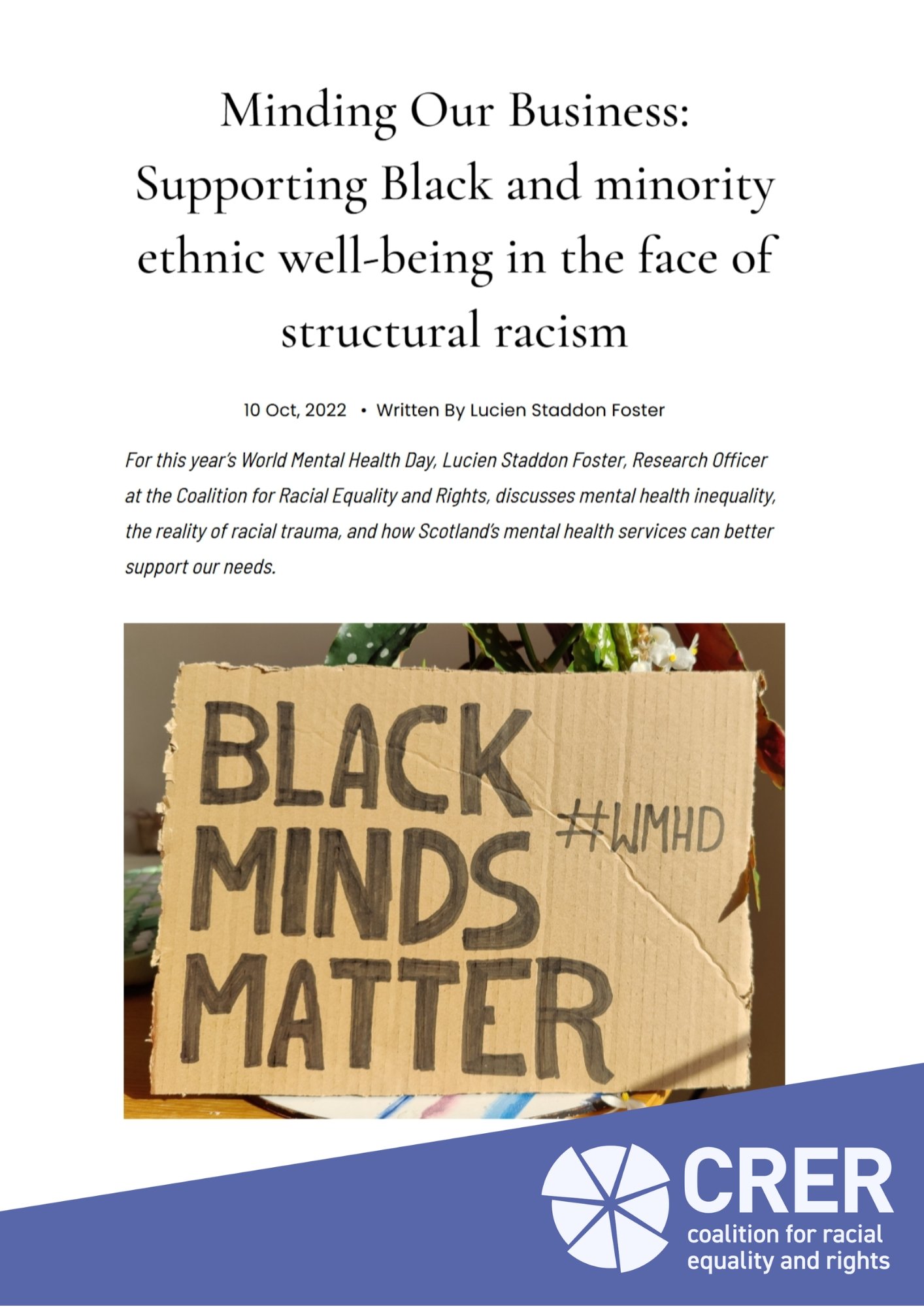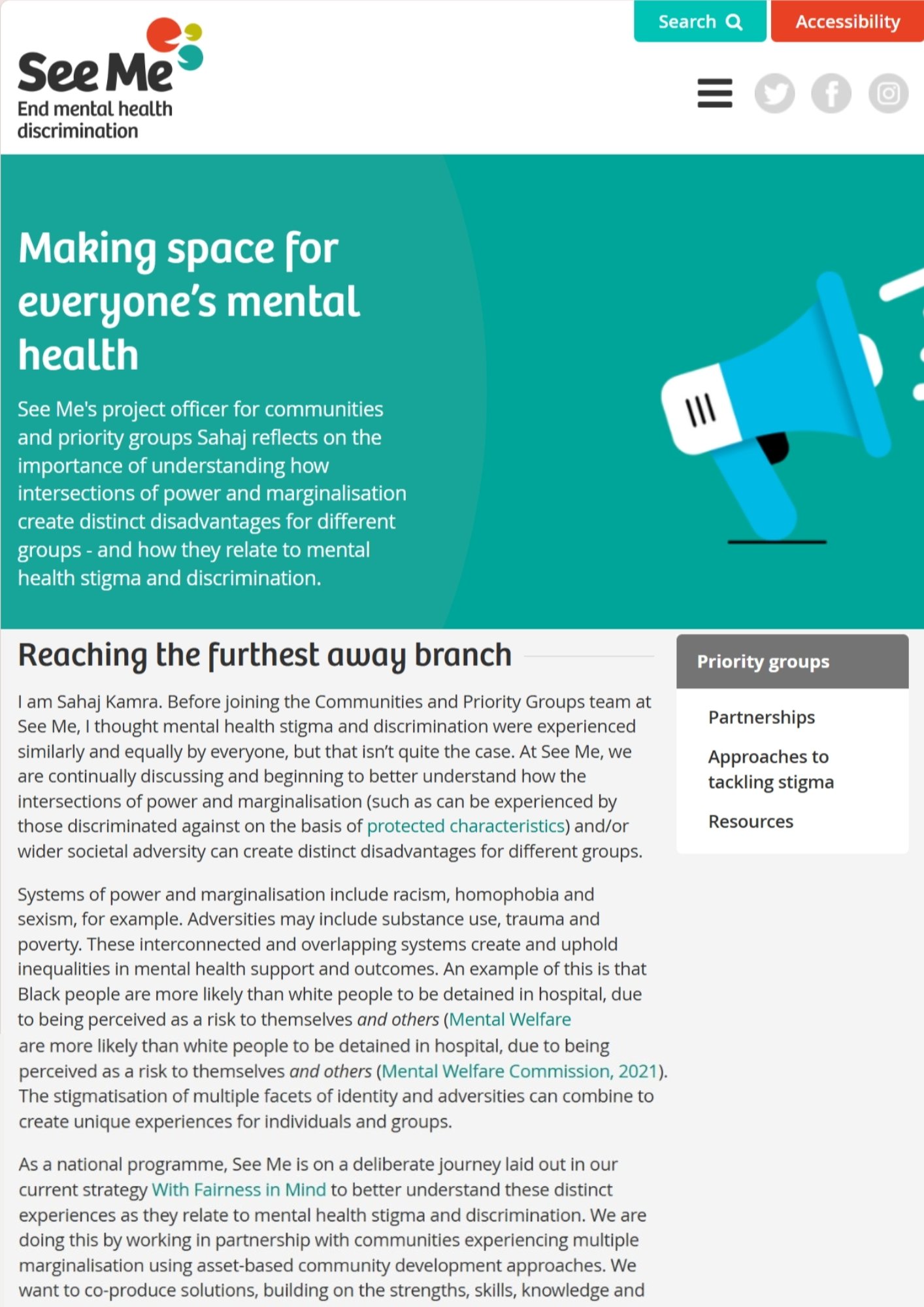Psychosis: Neglecting the “Ugly” side of Mental Health for BME people
For Mental Health Awareness Week 2025, Kafui Akpo-Young writes about psychosis and ethnicity, exploring how racism, intersectional stigma and cultural distance can shape people’s experiences of severe mental illness and the types of treatment they receive.
This guest blog was written by Kafui Akpo-Young, a post-graduate student at the University of Glasgow studying Global Migrations and Social Justice. For several months, Kafui volunteered with the Coalition for Racial Equality and Rights (CRER) to produce research on racialised inequalities in mental health and maternal health.
Mental health has become a very popularised subject in recent years, with much of the discussion focused on encouraging people to speak out on their issues. What often gets neglected in these conversations is the “uglier” side of mental health, such as psychotic disorders.
People who experience psychosis can face stigma at personal, social and institutional levels. As a result, psychosis tends to be a taboo topic, and unfortunately, that in itself can lead to Black and minority ethnic (BME) people being unfairly targeted and mistreated within the mental health care system.
Hospital admission rates and detention rates are some ways of understanding the mental health situation for Black and minority ethnic people. This data can show the prevalence of severe health difficulties among specific BME groups and how they may be perceived by those in the healthcare system.
Psychosis
Data on the prevalence of psychosis across racial groups is limited in Scotland, but existing research shows that psychosis rates are strongly linked to ethnicity, more so than other mental health conditions. Psychosis is an important matter that requires improved data collection from Scottish Government and Public Health Scotland for the monitoring of racial disparities.
From a UK perspective, numerous studies show higher rates of psychosis among BME groups. In some cases, psychosis can be six times higher in BME groups than in their white counterparts. These figures aren’t isolated, as similar results have been found across other European countries and in the US. We need to have context to understand why these rates of diagnoses occur and how these findings can apply in Scotland.
One of the potential explanations for these rates is cultural distance, which can be shown further by comparing the rate of psychosis in Caribbean countries with the UK. Cultural distance refers to Black and minority ethnic groups having differing social values and customs from ‘mainstream’ society. These values and customs are typically linked to their heritage and may challenge the Eurocentric values in Western society. As a result, BME groups can face an increased risk of severe mental health conditions, such as psychosis, because their own cultural norms are seen as ‘anti-Western’ and therefore abnormal.
Despite the rates of psychosis being almost five times higher in the Black Caribbean or Black African UK population in comparison to their white counterparts, the same figures cannot be found in Caribbean countries. This suggests that the rates of psychosis are dependent on environment and context, which leads to cultural distance being thought of as a strong reason for these rates.
Another factor in higher psychosis rates for BME people is socio-economic disadvantage. For example, BME groups unable to communicate through the main language of the society (English) due to a lack of knowledge of it or through the inability to speak the language fluently can increase the chances of a person developing psychosis. Although this isn’t necessarily a situation that is exclusive to BME groups, the accumulation of multiple material and social disadvantages creates heightened distress. The cultural distance between BME groups and mainstream society increases the potential for psychosis, too, through a feeling of detachment and powerlessness.
Dr Hannah Jongsma from University College London explains: “Experiencing a lack of control over your own life may disrupt the dopamine system – a signalling system in the brain – which is known to be important in developing psychosis and is very sensitive to environmental factors”.
The stark reality of the damage caused by cultural distance should encourage preventative action in Scotland to support BME communities. However, the detachment between Black and minority ethnic communities and mainstream society persists as the mainstream is dominated by the ethnic majority. There must be a greater focus on addressing psychosis within BME communities in Scotland.
A Glasgow-based study on psychosis and hospital admission rates showed the differences in psychosis diagnoses in BME people compared to the white Scottish population. The study considered different levels of deprivation in areas of Glasgow and found that psychosis was more common in areas that were less deprived, although it was still present in the most deprived areas too. This shows that deprivation isn’t the sole reason, as there are larger differences between ethnic groups in less deprived areas.
The same study revealed that there was a greater prevalence of psychosis where “ethnic density was lower”. The smaller the BME population, the more detached from the mainstream they become, and the more likely psychosis will develop. However, due to the small sample size and this study being the first of its kind in Scotland, we cannot generalise the findings. This again suggests the need to push for more ethnicity data when looking at psychosis diagnoses.
Admission Rates
Hospital admissions data serve as an important indication of the growing rates of psychosis within BME communities and provide insights into the types of admissions people are subjected to.
UK-wide statistics can be used to determine the proportion of admissions for psychotic disorders that were compulsory or that required police involvement. These show that more than 60% of Black African or Black Caribbean patients had police involved in at least one of their admissions in comparison with 37% for white British patients. This comes after it was shown that Black African or Black Caribbean patients are also 20% more likely to be admitted than white patients.
These statistics support Scotland-specific findings from the 2021 Mental Welfare Commission report that BME people (Black people in particular) are more likely to be seen as a threat when they are severely mentally ill. BME people were more likely to be admitted and detained in the least preferred method for a patient, emergency detentions, in comparison to white people, who are more likely to be admitted under short-term detentions.
The differences between these detentions are crucial in understanding the racial inequalities, as detentions for BME patients are often involuntary and tend to last longer on average than a white patient’s detention. The detention for white patients is shorter on average, and although still involuntary, they are more likely to benefit from the safeguarding measures put in place, such as requiring consent from an Independent Mental Health Officer before carrying out the detention.
An argument in favour of these detentions would be that BME people require greater care due to a more severe illness but in the same report, it was found that the reasoning behind these types and rates of detention is that BME people are seen as being a “greater risk to self and others” than to just themselves. On the other hand, white patients are seen as being more of a risk to themselves rather than to others.
Old racial tropes and biases seem to play a role here. Evidence heard in the ongoing Sheku Bayoh Public Inquiry highlights how racist tropes around danger and mental illness can lead to devastating consequences. Given that racism is a massive factor in BME people developing severe mental illnesses, further racial inequality within mental health services can only worsen the situation.
Although the Mental Welfare Commission report was a call to action in 2021, more data needs to be released on racial disparities in all severe mental illnesses. Moreover, a major factor in these illnesses developing is distance from the mainstream within a racist society. Without further action to combat these discriminatory attitudes, the consequences for BME people in Scotland could be devastating.



